This was published 5 years ago
Scoresby Sund cruise, Greenland: The mystery of the world's largest island
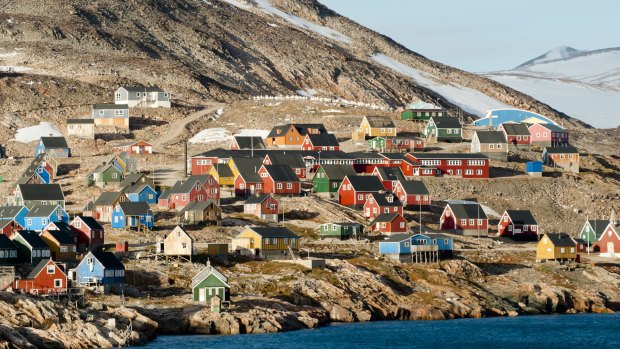
Ittoqqortoormiit village, Greenland's most remote village.
Why is Greenland called Greenland? What does muskox taste like? And who on earth is Jan Mayen? An expedition cruise in the Arctic fiords of East Greenland with Hurtigruten – Norway's coastal express gone astray – raises questions I'd never thought to ask and reveals secrets of a world I never expected to see.
Greenland is the largest island on earth that isn't also a continent. The massive permanent ice sheet covering more than 80 per cent of its 2.17 million square kilometres is so heavy the land beneath has depressed into a basin sinking hundreds of metres below sea level. On the upside, Greenland's highest point is 3700 metres.
I've often wondered how Greenland fits into things and, in fact, the country is geographically and geologically part of the North American continent but politically attached to Europe. BBC News defines Greenland as "an autonomous Danish dependent territory with limited self-government and its own parliament". The Danish krone is the official currency and almost all Greenlandic people have Danish names and can speak Danish, yet most of its 57,000 or so residents reportedly want total independence.
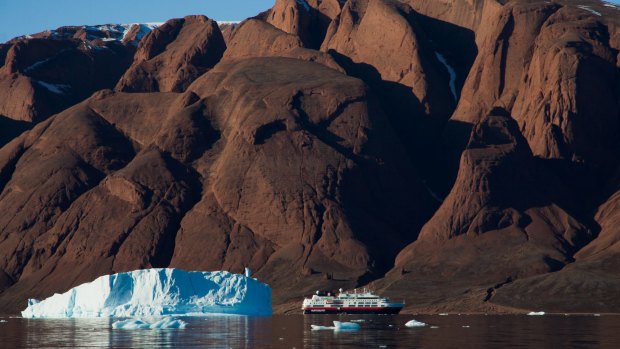
11.5-tonne Fram had been hidden behind this berg in Fonfjord, Greenland.
Scoresby Sund, arguably the world's largest fiord system, penetrates East Greenland at an Arctic latitude of 70.48 degrees north. These Greenland Sea fiords extend hundreds of kilometres inland with an overall surface area close to 38,000 square kilometres. Sydney Harbour, for some perspective, has a surface area of 55 square kilometres.
Over six days our ship, MS Fram, navigates Fonfiord, Rode Fiord, Hare Fiord and Ofiord. Hurtigruten vessels have sailed Scoresby Sund in the past but this new Greenland itinerary dedicates extra days to exploring the area and so Fram is able to venture deeper into the system than any of the fleet has before. Apart from whale-watchers on an oak Icelandic fishing boat and one other expedition ship, we see very little human activity on the water.
Greenland is the world's least densely populated country and Scoresby Sund, despite its enormity, is a one-town fiord. The only permanent settlement, Ittoqqortoormiit (pronounced ee-toko-TOOR-mit), has fewer than 500 residents living fiord-side in colourful houses built straight onto the rock. It has everything you'd expect a small town would plus working sled dogs you shouldn't pat, a helipad and graves that were dug out of the hard land using plastic explosives.
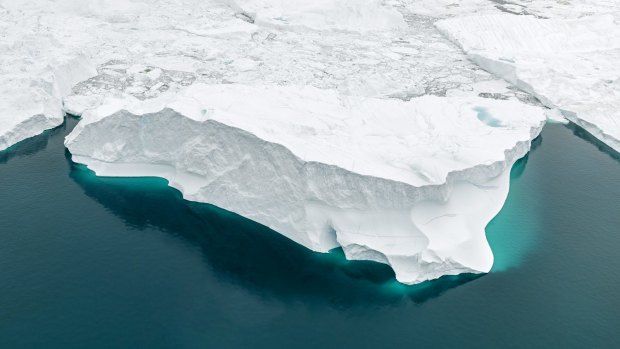
Ilulissat icefiord, Greenland.
When 150 foreigners in matching weatherproof jackets descend on Ittoqqortoormiit, some local people are in traditional costume and others have been employed to answer questions. An artist has opened the doors of her home studio to us, the tourist shop is selling precious Inuit handicrafts and an elder seated in a tent lined with thick pelts offers us small pieces of well-cooked meat. It's muskox – a hoofed mammal best described as a smaller longer-haired bison you'd never want to be headbutted by that tastes nothing like chicken. More like a gamey beef.
The expedition leader for this journey believes it necessary to have a local expert with us while sailing Scoresby Sund. Mohawked millennial Niels Rassmussen is the 11th generation of his family to live in Ittoqqortoormiit. He learnt English from video games as a child, had two years of his tertiary education in Denmark and is a self-proclaimed "odd jobs specialist and free-time hunter" (meaning he hunts in his free time). This exception to his own rule describes Greenlandic people, to a lounge of strangers on a ship he's just boarded for the first time, as shy and reserved.
Fram's mainly Nordic expedition crew fully embrace Rassmussen. On board and onshore, he helps them and us understand a place he calls the edge of life.
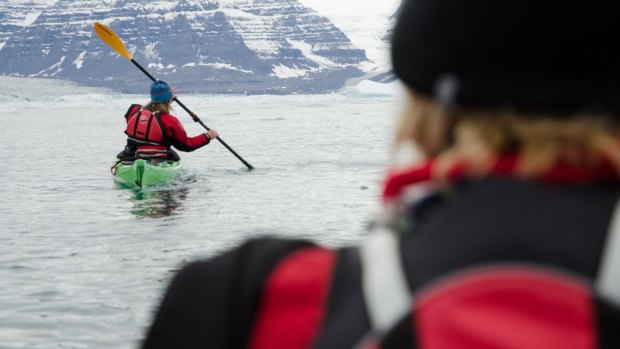
Kayaking in Vikingebukt Greenland.
Geologically, Scoresby Sund is about as dramatic as you can get without anything actually blowing its top in front of you. Rock has been thrust and folded, uplifted and eroded so that now – a billion years after much of it first materialised – Scoresby Sund's impossibly grand fiord walls are formed from bare-naked grey and black and orange and Uluru-red mountainsides. Patches and dustings of snow decorate higher features. Glaciers grind to the water's edge and lose face. Liquid horizons are obscured by inconceivably large icebergs. For one day, mist is at play. Walking the tundra fields of Hekla Havn on Denmark Island, Rodepynt, Bear Islands and South Cape we are like tiny red ants.
When we're on land some of the expedition crew stand armed at strategic highpoints keeping a lookout for polar bear. From the ship we watch for surfacing walrus, seal, humpback whale, beluga whale, narwhal and Greenland shark. Some of the bird species barely sound real: pink-footed goose, puffin, Arctic tern, ptarmigan, little auk, gyrfalcon.
When Rassmussen talks about wildlife, it's almost always in relation to hunting which, for him, means being "in connection with yourself and in connection with nature". Protein-rich food sources such as muskox, seal, walrus, fish and even polar bear are part of the East Greenlandic ancestral diet. Midwinter temperatures here can drop to 20 below (plus wind chill), supermarket supplies are limited and expensive and, as Rassmussen says, "it's my way of living". Some women hunt, especially if born into a hunting family, as Rassmussen's mother was. In winter, groups can wait for hours or days in the frozen darkness for one seal. Summer is easier: "You only have to prepare your boat and your rifle and you just go out".
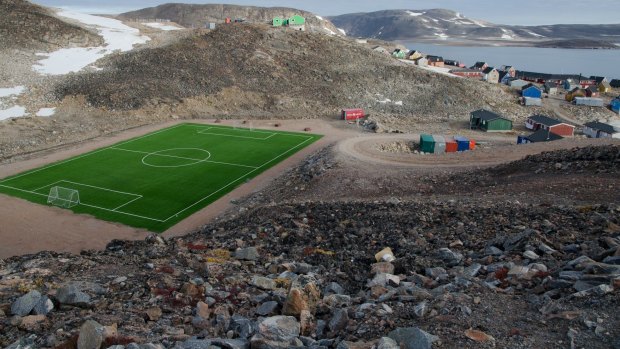
The greenest place in East Greenland is in Ittoqqortoormiit.
English has adopted Greenlandic words such as kayak and anorak. Yet only in 2008 did this Inuit language join Danish as one of the island's official languages. Single words in Greenlandic can be simple enough, but sentences get tricky. The name for Greenland is Kalaallit Nunaat – that's manageable. But if you are able to say that you don't speak Greenlandic – which is "kalaallisut oqalussinnaanngilanga" – you're obviously lying.
Daytime temperatures sit about zero degrees and one sunny afternoon off red sandy Rodepynt beach I learn something new: you can charge into water that is minus one degree, hollering like a warrior and, pumped with adrenaline, go numb quickly enough to then "comfortably" remain submerged, seemingly indefinitely. You do, however, need to keep an eye on the time – after 12 minutes in water of that temperature internal organs can start to shut down.
Between shore excursions there's a constant stream of onboard lectures by academics and the expedition crew. History's greatest PR stunt, I learn, may very well have happened in Greenland. Despite being one of the least green places on earth, it was named thus by a Norseman, Eric the Red, who led the Viking settlement of the island in the late 10th century. That was during the Medieval Warm Period, a few hundred years of abnormally warm weather, so it's quite possible Greenland was greener than it is now but, more likely, Eric deliberately gave it the misleading name to encourage others to join his crazy scheme.
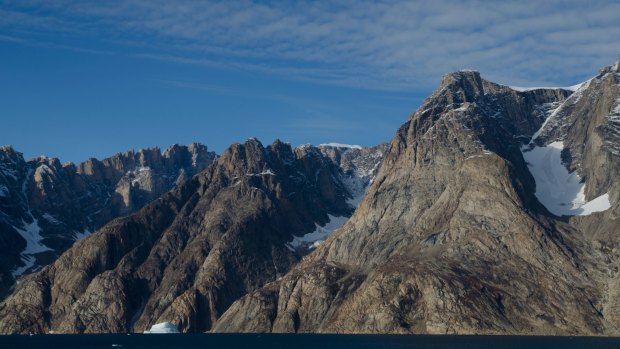
Scoresby Sund Fonfjord, Greenland.
Another unsolved mystery of history is why the Vikings eventually disappeared from Greenland. The main theory seems to be their failure to keep domestic cattle alive due to the absence of green pastures promised by Eric's campaign. Bored to bits with seal meat, they plaited their sideburns and sailed.
As for modern history, there's a glacier in Ilulissat Icefiord on the other side of the country in Western Greenland – Hurtigruten sails there too – called Jakobshavn. Calving billions of tonnes of icebergs every year, it's the most productive glacier in the Northern Hemisphere. Many believe one of its bergs sank the Titanic.
In terms of global warming, the northeast Greenland ice sheet is losing billions of tonnes of ice a year and the rate of melt is on the increase. But "if I look through the eyes of a hunter, climate change is good," says Rassmussen, recognising warmer waters support more fish species. Shrinking of the ice cap and harbours that are ice free all year will also mean easier access to the country's untapped minerals. That could improve Greenland's economy and help it reach total independence. It could also be the beginning of the end.
After Rassmussen has returned to Ittoqqortoormiit , we've bid Scoresby Sund goodbye and sailed east for a day in heavy weather, I finally understand why Jan Mayen hasn't been returning my calls. JM turns out to be a moody 55-kilometre-long tadpole-shaped volcanic island in the Arctic Ocean between Greenland and Northern Norway. These days, Jan Mayen (pronounced yarn MY-an) belongs to Norway and is inhabited, at any one time, by 18 meteorologists pretending they're all getting on.
Black soil supports bright green moss, beaches are littered with bleached whale bones and the beautiful 2277-metre Beerenberg at the island's head is the world's northernmost active volcano. Jan Mayen has no harbour so Fram anchors in the swell. Given its exposed location, the island is notoriously inaccessible. if you sail the Arctic with an expedition crew on board they'll always do everything they can to get you to shore.
TRIP NOTES
Elspeth Callender travelled as a guest of Hurtigruten.
MORE
Hurtigruten's 12-day Greenland and Iceland: The Ultimate Fjord and National Park Experience departs Oslo, Norway on July 26, 2019, and ends in Reykjavik, Iceland. Priced from $8250 a person. Contact Bentours for e-brochures and bookings, bentours.com.au
See also: See the world's largest island before it changes forever
Sign up for the Traveller Deals newsletter
Get exclusive travel deals delivered straight to your inbox. Sign up now.